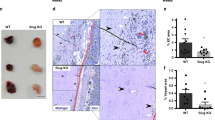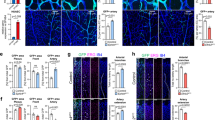Abstract
Myeloid cells are a feature of most tissues. Here we show that during development, retinal myeloid cells (RMCs) produce Wnt ligands to regulate blood vessel branching. In the mouse retina, where angiogenesis occurs postnatally1, somatic deletion in RMCs of the Wnt ligand transporter Wntless2,3 results in increased angiogenesis in the deeper layers. We also show that mutation of Wnt5a and Wnt11 results in increased angiogenesis and that these ligands elicit RMC responses via a non-canonical Wnt pathway. Using cultured myeloid-like cells and RMC somatic deletion of Flt1, we show that an effector of Wnt-dependent suppression of angiogenesis by RMCs is Flt1, a naturally occurring inhibitor of vascular endothelial growth factor (VEGF)4,5,6. These findings indicate that resident myeloid cells can use a non-canonical, Wnt–Flt1 pathway to suppress angiogenic branching.
This is a preview of subscription content, access via your institution
Access options
Subscribe to this journal
Receive 51 print issues and online access
$199.00 per year
only $3.90 per issue
Buy this article
- Purchase on Springer Link
- Instant access to full article PDF
Prices may be subject to local taxes which are calculated during checkout




Similar content being viewed by others
References
Gerhardt, H. et al. VEGF guides angiogenic sprouting utilizing endothelial tip cell filopodia. J. Cell Biol. 161, 1163–1177 (2003)
Ching, W. & Nusse, R. A dedicated Wnt secretion factor. Cell 125, 432–433 (2006)
Carpenter, A. C., Rao, S., Wells, J. M., Campbell, K. & Lang, R. A. Generation of mice with a conditional null alelle for Wntless . Genesis 48, 554–558 (2010)
Ambati, B. K. et al. Corneal avascularity is due to soluble VEGF receptor-1. Nature 443, 993–997 (2006)
Kendall, R. L. & Thomas, K. A. Inhibition of vascular endothelial cell growth factor activity by an endogenously encoded soluble receptor. Proc. Natl Acad. Sci. USA 90, 10705–10709 (1993)
Shibuya, M. Structure and dual function of vascular endothelial growth factor receptor-1 (Flt-1). Int. J. Biochem. Cell Biol. 33, 409–420 (2001)
Pipp, F. et al. VEGFR-1-selective VEGF homologue PlGF is arteriogenic: evidence for a monocyte-mediated mechanism. Circ. Res. 92, 378–385 (2003)
Machnik, A. et al. Macrophages regulate salt-dependent volume and blood pressure by a vascular endothelial growth factor-C-dependent buffering mechanism. Nature Med. 15, 545–552 (2009)
Lin, E. Y. & Pollard, J. W. Tumor-associated macrophages press the angiogenic switch in breast cancer. Cancer Res. 67, 5064–5066 (2007)
Stockmann, C. et al. Deletion of vascular endothelial growth factor in myeloid cells accelerates tumorigenesis. Nature 456, 814–818 (2008)
Kubota, Y. et al. M-CSF inhibition selectively targets pathological angiogenesis and lymphangiogenesis. J. Exp. Med. 206, 1089–1102 (2009)
Fantin, A. et al. Tissue macrophages act as cellular chaperones for vascular anastomosis downstream of VEGF-mediated endothelial tip cell induction. Blood 116, 829–840 (2010)
Martin, P. et al. Wound healing in the PU.1 null mouse–tissue repair is not dependent on inflammatory cells. Curr. Biol. 13, 1122–1128 (2003)
Grunewald, M. et al. VEGF-induced adult neovascularization: recruitment, retention, and role of accessory cells. Cell 124, 175–189 (2006)
Saint-Geniez, M. & D'Amore, P. A. Development and pathology of the hyaloid, choroidal and retinal vasculature. Int. J. Dev. Biol. 48, 1045–1058 (2004)
Mendes-Jorge, L. et al. Scavenger function of resident autofluorescent perivascular macrophages and their contribution to the maintenance of the blood-retinal barrier. Invest. Ophthalmol. Vis. Sci. 50, 5997–6005 (2009)
Lobov, I. B. et al. WNT7b mediates macrophage-induced programmed cell death in patterning of the vasculature. Nature 437, 417–421 (2005)
Deng, L. et al. A novel mouse model of inflammatory bowel disease links mammalian target of rapamycin-dependent hyperproliferation of colonic epithelium to inflammation-associated tumorigenesis. Am. J. Pathol. 176, 952–967 (2010)
Yamaguchi, T. P., Bradley, A., McMahon, A. P. & Jones, S. A. Wnt5a pathway underlies outgrowth of multiple structures in the vertebrate embryo. Development 126, 1211–1223 (1999)
Majumdar, A., Vainio, S., Kispert, A., McMahon, J. & McMahon, A. P. Wnt11 and Ret/Gdnf pathways cooperate in regulating ureteric branching during metanephric kidney development. Development 130, 3175–3185 (2003)
Seifert, J. R. & Mlodzik, M. Frizzled/PCP signalling: a conserved mechanism regulating cell polarity and directed motility. Nature Rev. Genet. 8, 126–138 (2007)
Bryja, V. et al. The extracellular domain of Lrp5/6 inhibits noncanonical Wnt signaling in vivo . Mol. Biol. Cell 20, 924–936 (2009)
Grumolato, L. et al. Canonical and noncanonical Wnts use a common mechanism to activate completely unrelated coreceptors. Genes Dev. 24, 2517–2530 (2010)
Chappell, J. C., Taylor, S. M., Ferrara, N. & Bautch, V. L. Local guidance of emerging vessel sprouts requires soluble Flt-1. Dev. Cell 17, 377–386 (2009)
Haigh, J. J. et al. Cortical and retinal defects caused by dosage-dependent reductions in VEGF-A paracrine signaling. Dev. Biol. 262, 225–241 (2003)
Lichtenberger, B. M. et al. Autocrine VEGF signaling synergizes with EGFR in tumor cells to promote epithelial cancer development. Cell 140, 268–279 (2010)
Blumenthal, A. et al. The Wingless homolog WNT5A and its receptor Frizzled-5 regulate inflammatory responses of human mononuclear cells induced by microbial stimulation. Blood 108, 965–973 (2006)
Stockmann, C. et al. Deletion of vascular endothelial growth factor in myeloid cells accelerates tumorigenesis. Nature 456, 814–818 (2008)
Lin, S. L. et al. Macrophage Wnt7b is critical for kidney repair and regeneration. Proc. Natl Acad. Sci. USA 107, 4194–4199 (2010)
Tauber, A. I. Metchnikoff and the phagocytosis theory. Nature Rev. Mol. Cell Biol. 4, 897–901 (2003)
Rohan, R. M., Fernandez, A., Udagawa, T., Yuan, J. & D’Amato, R. J. Genetic heterogeneity of angiogenesis in mice. FASEB J. 14, 871–876 (2000)
Gao, G. et al. Difference in ischemic regulation of vascular endothelial growth factor and pigment epithelium–derived factor in Brown Norway and Sprague Dawley rats contributing to different susceptibilities to retinal neovascularization. Diabetes 51, 1218–1225 (2002)
Chan, C. K. et al. Mouse strain-dependent heterogeneity of resting limbal vasculature. Invest. Ophthalmol. Vis. Sci. 45, 441–447 (2004)
Chan, C. K. et al. Differential expression of pro- and antiangiogenic factors in mouse strain-dependent hypoxia-induced retinal neovascularization. Lab. Invest. 85, 721–733 (2005)
Nagy, A., Gertsenstein, M., Vintersten, K. & Behringer, R. Manipulating the mouse embryo: a laboratory manual. 3rd edn, 371–373 (Cold Spring Harbor Laboratory Press, 2003)
Carpenter, A. C., Rao, S., Wells, J. M., Campbell, K. & Lang, R. A. Generation of mice with a conditional null allele for Wntless . Genesis 48, 554–558 (2010)
Novak, A., Guo, C., Yang, W., Nagy, A. & Lobe, C. G. Z/EG, a double reporter mouse line that expresses enhanced green fluorescent protein upon Cre-mediated excision. Genesis 28, 147–155 (2000)
Acknowledgements
We thank P. Speeg for technical assistance and A. P. McMahon for the Wnt11 mice. This work was supported by the NIH (J.A.S., M.W-K., J.W.P., J.D.M., T.Y., B.O.W., R.A.L.) by the HHMI (J.D.M.) and Cancer Research UK (H.G.).
Author information
Authors and Affiliations
Contributions
R.A.L provided project leadership and wrote the manuscript with J.A.S. J.A.S., I.L., S.R., H.G., and R.A.L. designed the experiments. J.A.S, I.L., S.R., G.M., A.C.C., A.R.B., J.F., and R.A. performed the experiments. S.R., J.W.P., T.Y., N.F. and B.O.W developed critical reagents. Experimental supervision and helpful discussions were provided by M.W-K., J.D.M., S.R., J.W.P., and H.G.
Corresponding author
Ethics declarations
Competing interests
[Competing interest: N.F. is an employee of Genentech Inc. The authors declare no other potential conflicts of interest.]
Supplementary information
Supplementary Information
The file contains Supplementary Figures 1-5 with legends, Supplementary Table 1 and additional references. (PDF 3021 kb)
Rights and permissions
About this article
Cite this article
Stefater III, J., Lewkowich, I., Rao, S. et al. Regulation of angiogenesis by a non-canonical Wnt–Flt1 pathway in myeloid cells. Nature 474, 511–515 (2011). https://doi.org/10.1038/nature10085
Received:
Accepted:
Published:
Issue Date:
DOI: https://doi.org/10.1038/nature10085
This article is cited by
-
Amyloid-β (Aβ) immunotherapy induced microhemorrhages are associated with activated perivascular macrophages and peripheral monocyte recruitment in Alzheimer’s disease mice
Molecular Neurodegeneration (2023)
-
Exploiting synergistic effect of CO/NO gases for soft tissue transplantation using a hydrogel patch
Nature Communications (2023)
-
The role of macrophages in the tumor microenvironment and tumor metabolism
Seminars in Immunopathology (2023)
-
Non-canonical WNT signalling in cardiovascular disease: mechanisms and therapeutic implications
Nature Reviews Cardiology (2022)
-
Neural crest cell-derived pericytes act as pro-angiogenic cells in human neocortex development and gliomas
Fluids and Barriers of the CNS (2021)
Comments
By submitting a comment you agree to abide by our Terms and Community Guidelines. If you find something abusive or that does not comply with our terms or guidelines please flag it as inappropriate.



